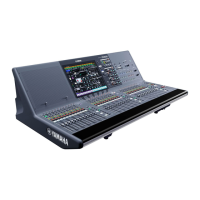
Do you have a question about the Yamaha RIVAGE PM3 CS-R3 and is the answer not in the manual?
| Type | Digital Mixing Console |
|---|---|
| Control Surface | CS-R3 |
| Sample Rate | 96 kHz |
| Bit Depth | 24-bit |
| Internal Processing | 32-bit floating point |
| Dante Ports | 2 |
| Weight | 38 kg (83.8 lbs) |
| Outputs | 16 |
| Fader Configuration | Motorized |
| Touch Screen | Yes |
| Network I/O | Ethernet |
| Power Supply | AC100V-240V 50/60Hz |
| Power Requirements | 100-240V AC |
| Power Consumption | Approx. 200 W |
Guidance on safe use and handling of the power cord and plug.
Warnings against opening the unit and precautions for water/fire hazards.
Guidelines for safe placement and connection of the product.
Product handling precautions and instructions for backup battery replacement.
How to operate the touch screen for menus, parameters, and button control.
Encoder functions for channel strips and controls like SEL, CUE, ON, and Fader.
Selects input/output layers (A-F) for fader mapping.
Step-by-step guide for connecting the unit to AC outlets using supplied power cords.
Procedure for safely shutting down the control surface to prevent data damage.
Procedure for installing a Mini-YGDAI card into the MY card slots.
Procedure for safely removing a Mini-YGDAI card from the MY card slots.
Procedure to reset internal memory to factory defaults, losing saved content.
Corrects motorized fader movement discrepancies via calibration.